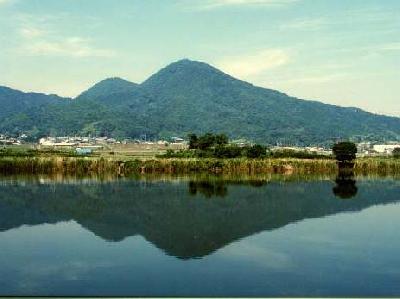|
Nijyozan Mountain, despite its low altitude, is the most historic mountain in all of Nara Prefecture, and is located between the Ikoma Mountain range and the Katsuragi Mountain range.
If you look at it from the Osaka Prefecture side, it resembles the shape of a camel's back. The Odake (Male Mountain), which has an altitude of 517m, and the Medake (Female Mountain), with an altitude of 474m, are the two round mountain peaks which make up the Nijyozan.
At the summit of the Odake is the grave of Prince Otsu (poet and son of Emperor Temmu), who was executed on the suspicion of rebellion. Some people may know the Manyoushu (Song of Ten Thousand Leaves), which Princess Ookuno composed in memory of her younger brother. The song 'Utsusomino-Hitonaruwareya-Asuyoriwa-Nijyouzanwo-Otoutoyotowagamimu' describes the princess's feelings of pain and sadness for her brother.
The Nijyozan is currently being prepared to become a Natural Park called the Manyou-no-Mori ('forest of ten thousand leaves'). Besides mountain climbing, people can enjoy touring of historic sites, such as the cave temples dating to the Nara period and stone monuments inscribed with tanka poems from the Manyoushu.
On holidays, the Nijyozan is full of visitors who have come to enjoy a pleasant stroll.
If you look at it from the Osaka Prefecture side, it resembles the shape of a camel's back. The Odake (Male Mountain), which has an altitude of 517m, and the Medake (Female Mountain), with an altitude of 474m, are the two round mountain peaks which make up the Nijyozan.
At the summit of the Odake is the grave of Prince Otsu (poet and son of Emperor Temmu), who was executed on the suspicion of rebellion. Some people may know the Manyoushu (Song of Ten Thousand Leaves), which Princess Ookuno composed in memory of her younger brother. The song 'Utsusomino-Hitonaruwareya-Asuyoriwa-Nijyouzanwo-Otoutoyotowagamimu' describes the princess's feelings of pain and sadness for her brother.
The Nijyozan is currently being prepared to become a Natural Park called the Manyou-no-Mori ('forest of ten thousand leaves'). Besides mountain climbing, people can enjoy touring of historic sites, such as the cave temples dating to the Nara period and stone monuments inscribed with tanka poems from the Manyoushu.
On holidays, the Nijyozan is full of visitors who have come to enjoy a pleasant stroll.
| [+ADDRESS] | 
|












